German amphibious warfare in WW2:
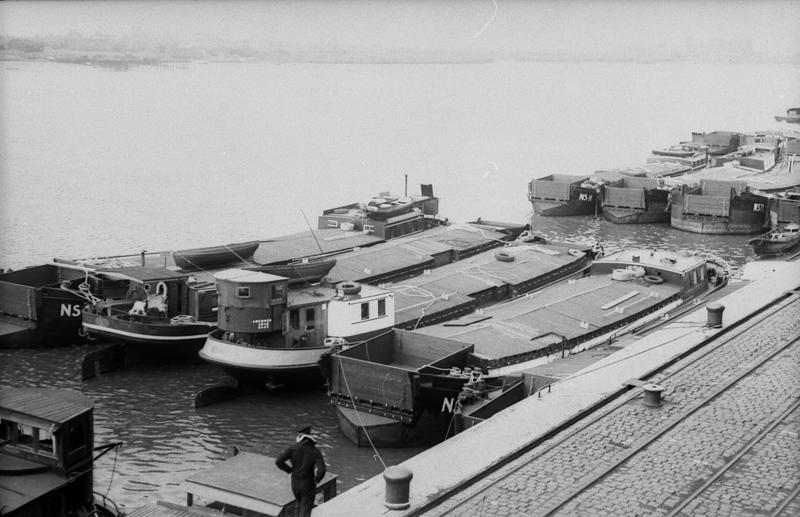
Prahme, converted riverine barges converted as landing ships in Wilhelmshaven, as part of the prevision for Operation Sealion, summer 1940.
Whereas the focus on WW2 allied landings is very clear, the axis made a number of amphibious operations of smaller scale, first because of the lower need for such operations, and for the lack of naval support. As everyone knows, the so-called Blitzkrieg was a land and air combined arms affair, and that was considered enough to conquer and occupy all Europe and later to settle matters in North Africa.
The Baltic was indeed disputed between the Kriegsmarine and Soviet Navy. There were still some stronghold in the Mediterranean, but nearly any place was reachable by land, and when an assault was requiring another way, paratroopers were massively deployed instead, like in Crete.
Therefore the Kriegsmarine never had a dedicated amphibious arm, and instead the Army or Luftwaffe services were mobilized to produce ad hoc landing crafts for a specific operation, using local steamers. But looking into what type of craft or ship was designed and tactics used, required having a look at German landings and amphibious operations during WW2.
Prior to that, Germany had little experience of large amphibious operations: In WW1 the game was mastered (the hard way) by the allies notably at Gallipoli. The German Empire however planned in 1917 Operation Albion, an attempt to occupy West Estonian Archipelago, by then a part of the Russian Empire.
The operation was a success, after mobilizing 1 battlecruiser, 10 dreadnoughts, 9 light cruisers, 1 mine cruiser, 50 TBs, 6 U-boats, 6 airships and 19 transports. About 24,500 soldiers 8,500 horses and 2,400 vehicles were landed on various boats, and the Russian naval losses were considerable. This remained in the back of the heads of the general staff in 1940.
Operation Weserübung (9 April 1940)
Litterally “Weser exercize”. This was a preventive move, to avoid seeing the allies occupying Norway and cutting the “iron road”, the country being the main iron ore supplier to Germany. After a warning in October 1939 by Erich Raeder that the British navy blockade was likely to include the seizure of Norwegian ports, and later the mining of Norwegian waters (Operation Wilfred) in November, but this was denied twice.
Things evolved when the winter war erupted, and later the allies thought of supplying Finland through neutral countries like Sweden and ended with a plan to seize Narvik.
After reassuring himself about the intentions of the Norwegian government, after a meeting with Vidkun Quisling, Hitler ordered the Oberkommando der Wehrmacht (OKW) to plan the operation, named Studie Nord and on 14-19 January expanded by the Kriegsmarine. Their main intervention was to call for fast German warships to carry troops and material rather than using slow-moving merchant vessels, as it was right under the nose of the Home fleet (based at Scapa Flow). Surprise was the master word here.
Therefore, the Kriegsmarine surface fleet was totally mobilized for the effort. The plan was for these ships to carry and land in Norwegian ports a full army corps (mountain division, airborne division, motorized rifle brigade, two infantry divisions) targeting Oslo, Bergen, Narvik, Tromsø, Trondheim, Kristiansand, and Stavanger.
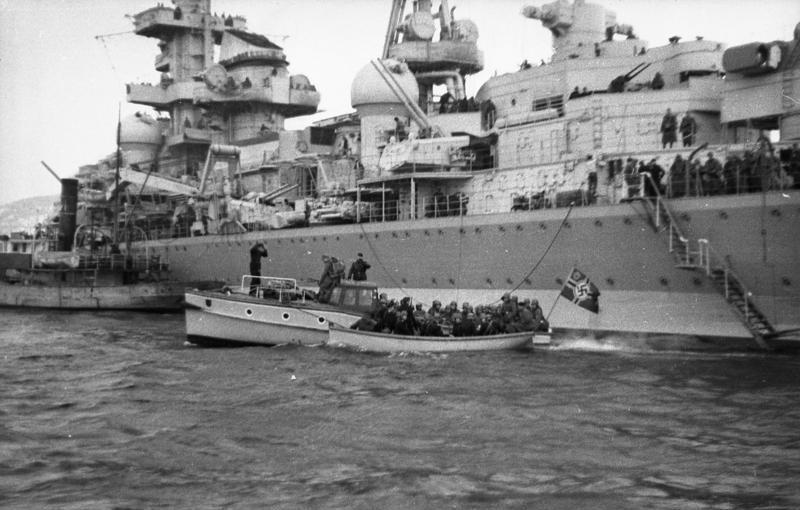
KMS Hipper disembarking troops to the coast, using her regular boats array.
For this were mobilized the Battleships Scharnhorst and Gneisenau (cover force), 10 destroyers carrying 2,000 mountaineering troops to Narvik, the Heavy cruiser Admiral Hipper and four destroyers (1,700 troops) to Trondheim, the Light cruisers Köln, Königsberg, artillery training ship Bremse, Schnellboot mothership Karl Peters, two torpedo boats and five motor torpedo boats (1,900 troops) to Bergen, the Light cruiser Karlsruhe, three TBs, seven MTBs, Schnellboot mothership Tsingtau (1,100 troops) to Kristiansand & Arendal, the Heavy cruiser Blücher and Lützow, light cruiser Emden, three TBs and eight minesweepers (2,000 troops) to Oslo and four minesweepers (150 troops) to Egersund. Another part of the operation included the invasion of Denmark, which was done by land.
Crucial to the success of these operations was Operation Hartmut, which for the Kriegsmarine included reuse of all available U-bootes already deployed in the Atlantic, re-routed for a screening operation, between the path of the Kriegsmarine and their objectives on the coast and a left flank attack by the Royal Navy.
As the events showed, the operation was successful and the main objective were achieved, triggering a response from the allies and the campaign of Norway which lasted until May 1940.
But in the process, the Kriegsmarine lost a considerable amount of ships: 1 heavy cruiser (by coastal gunfire), 2 light cruisers (allied aviation), 10 destroyers (mainly the two naval battles of Narvik), some U-boats, transports and smaller warships. The losses conducted Hitler to consider with more caution the use of warships for such operations.
It should be noted that only regular boats were used for the operations, in many cases the own service boats of the ships deployed.
The Danish part of Weserübung
The very same day the operations took place, the Heer and Luftwaffe, assisted by the Kriegsmarine, invaded Denmark. While the Danish Navy was not a match, in addition to land operations, the Navy landed troops in order to capture connections between Jutland and Zealand. These were fairly limited, to elements of the 198th Infantry Division at Funen.
However other landings were made in Korsør and Nyborg,effectively cutting off connections between Funen and Zealand. These troops in Korsør eventually made it on foot to Copenhagen at noon. There was also a night surprise attack on Gedser the southernmost city, simply using the local captured ferry at Warnemünde.
When inland, they swiftly moved to cut telephone lines and after reinforcements (second trip by the ferry) with light armour, they captured the Storstrøm Bridge, already held by paratroopers.
Operation Seelöwe (August 1940)
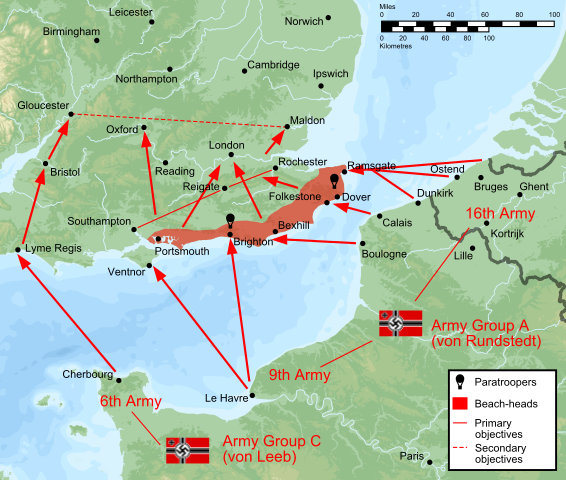
Probably the best-known of all these operations, and by far the largest: This was to be the Axis D-Day. After the fall of France, the Germans soon secured by the armistice treaty most of the coast they already controlled, all the way to the Spanish border.
This gave them a formidable coastal area facing the bay of Biscay up to the channel, and several naval bases on which they could launch attacks with surface ships (with dockyard basins large enough for the Bismarck and Tirpitz at Brest and St Nazaire).
In addition they had Rochefort and Lorient to base their U-Boats. However Hitler and his generals knew at Dunkirk they had broken the back of the BEF, despite the men were evacuated. They left behind all their heavy equipment, and at home only a few surviving WW1 training tanks and guns worthy of museum pieces. The industry was just trying to catch up. However Great Britain still counted on the Royal Navy and the RAF.

Invading Great Britain seemed obvious, with London so close to the future bridgeheads it was quite tempting. Plans for a massive amphibious assault were drawn since July already. However all knew that trying to conduct a landing armada along 30 km of water with the Royal Navy surging north and south would be a suicide. If the Luftwaffe would have attempted to intercept the ships, the RAF was there to pin it.
So it became imperious to destroyer the RAF first which would have left the Royal Navy without cover, an easy prey for the Stukas, which proved during the war, very efficient ships killers. Meanwhile officers in charge of the Operation Sealion were to devise a grand plan to carry as many as infantry and tanks they could with all means necessary. Many amphibious ships were therefore studied, and experiments on amphibious tanks as well (pic below), the ‘Tauchpanzers’.
Preparations for the invasion, designed at least to break the British resistance to German peace offers. The Channel (Der Kanal) was the only barrier, and admiral Erich Raeder was in charge of studying all possibilities of a naval assault across it, the first of it released as early as November 1939. Right away it made clear that enemy naval forces needed to be at least unable to intervene, and the threat of the RAF removed.
But coastal defences had to be also dealt with and enemy destroyers kept away. The plan was precised in the end, sanctioned by Hitler as Directive No. 16 in 16 July 1940 with a deadline. The Oberkommando des Heeres needed nine land divisions and two airborne divisions. The initial landing sites were between Dover and Portsmouth. The first schedule was fixed on September 17, 1940.
The first assault was to be made by two army groups drawn from the 6th Army, the 9th Army and the 16th Army. First wave: Eleven infantry and mountain divisions, plus two airborne divisions (3,000 men) and special forces of the Brandenburg Regiment (about 600, including Marine troops). They were tasked to create a large secured bridgehead and cut off reinforcement lines and control bridges.
Second wave: Eight panzer and motorised infantry divisions which were to give the means of a breakthrough to strategic objectives.
Third wave: Six further infantry divisions, following the main assault as customary with the Blitzkrieg, dealing with pockets of resistance and occupying positions in the rear, securing supply lines from the coast.
Key objective for long-term exploitation was the seizure of Folkestone and Newhaven, allowing major reinforcements to come by ship. The goal was to land at least two Panzerdivisions for further operations towards major cities. This order of battle was defined on 30 August and remained valid until the cancellation of the whole operation.
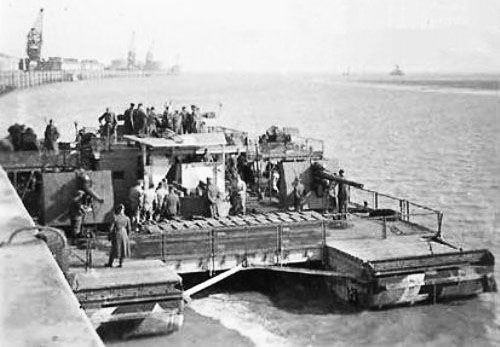
A Siebel barge, one of the improvized German vessel planned by the OKH for Operation Seelowe (see below, second part of this post).
Landing Echelons
The first echelon was to be carried in barges, coasters and small motor launches. The second was made by larger transport vessels, with artillery, armoured vehicles and heavy equipment. The third echelon was made of slower reinforcement division with infantry mainly and horses, on smaller ships and larger vessels.
British intelligence was quickly informed of the preparations, due to a visible accumulation of invasion barges in French ports, targeting the South coast. Home guards were redeployed accordingly along with reserves.
It should be noted that Mussolini proposed to Hitler to bolster the Luftwaffe by sending up to ten divisions and thirty squadrons of the Royal Italian air force for the invasion, and after some reluctance, Hitler agreed in the midst of the battle of Britain.
German Amphibious Tanks
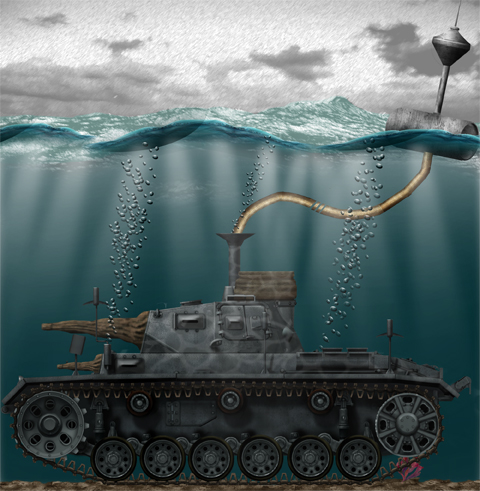
Among others, interesting developments came from concepts developed for the assault, that would be used when crossing large rivers in the east: The “floating Panzers”, Schwimmpanzers carried by Type C landing barges almost to shore, and the even more daring Tauchpanzers, or submarine Panzers, intended to cross also the last portion up to the shore underwater.
Some 52 Schwimmpanzers were made ready for the operation, whereas 160 Panzer IIIs, 42 Panzer IVs, and 52 Panzer IIs, carried by the Type B barge were also made ready, so on paper 250 amphibious tanks were to add their punch to the main assault, allowing to capture the two assigned deep-sea harbours. These experiments inspired in 1944 the famous “Horbart’s funnies”.
Kriegsmarine’s special crafts
In addition to the B and C Barges, the Kriegsmarine came out with several interesting proposals: A heavy landing bridge, not unlike the future mullberries, made by Krupp and tested in 1941-42. Dortmunder Union bridge competed but lost as the krupp system 32m long bridges were faster to assemble.
The Kriegsmarine ordered eight complete Krupp units composed of six platforms each, but this was later cancelled. The prototype completed however would serve to ship material in and out of the occupied channel island of Alderney.
Also they developed the Seeschlange (Sea Snake), a “floating roadway” made of articulated segments allowing to create a floating jetty. It was tested by the Army Training Unit at Le Havre in France in the autumn of 1941, and later prepared for use during the invasion of Malta, Unternehmen Herkules.
Potsponment and Cancellation
Adolf Hitler postponed Operation Seelowe as he was indeed persuaded that beating the Soviets would have deprived the British of the last possible ally. In between was launched Operation Adler, in order to given the Luftwaffe air superiority, a required condition for any invasion.
This, as we know, was not a promenade and the Blitz proved a failure for the Luftwaffe, leading to the postponement of Seelöwe, which became lower priority until its cancellation, especially in early 1942 with the USA at war, and setbacks in the USSR.
Due to the short time available, the Germans mustered all transports available in the region, trawlers from fishing village, rare suviving steamers, but mostly riverine barges, which proved the closest to landing ships possible when transformed. The smallest boats, requiring calm weather, were the speedboats used by the pioneers for the crossing of the Rhine in May 1940.
The Kriegsmarine at that tome had no dedicated amphibious ship and a program was launched to procure them as quickly as possible. Men and horses being easier to carry, artillery and armored vehicles were to be left behind, and to a secondary wave once an harbour was secured, which was a too risky proposition.
Modern analysts all agree that it was fortunate for Hitler to have postponed the operation in September: The depleted Kroegsmarine after Norway lacked the means to resist the Royal Navy, and losses within their airborne forces in the Netherlands had still not be replaced, whereas the Luftwaffe has been sensibly dented after its fight in France and the low countries.
There were still a few positive points: The Royal Navy was already engaged in the Atlantic and the Mediterranean but still what left of the Home Fleet largely outnumbered the any force the Germans can send in the channel. In addition, still in large numerical inferiority the RAF had advantages: By ordering to spare it in France and over Dunkirk, Churchill had preserved it, while quick reorganization allowed to train new pilots whereas the factories of Hawker and Supermarine had all priority.
In addition of mobilizing the aviation reserves and train the home guard, the planned network of radars in 1939 was made ready, giving UK the world’s best air C&C in the world.
War games at Sandhurst Royal Military Academy in 1974 concluded the Germans still could establish in July or August a bridgehead, using their heavy artillery on the coast and deploying mines in a corridor in the Channel to protect the initial assault. Nevertheless they would have been delayed on Home Guard Stop lines, leaving time for the regular British army troops to be trained, equipped and sent in reinforcement, in addition to the readily available ten lightly equipped divisions which survived Dunkirk.
After a few days, the Royal Navy was in reach of the English Channel, cutting off supplies and the invasion force would have been forced to surrender.
Operation Beowulf (8 September 1941)
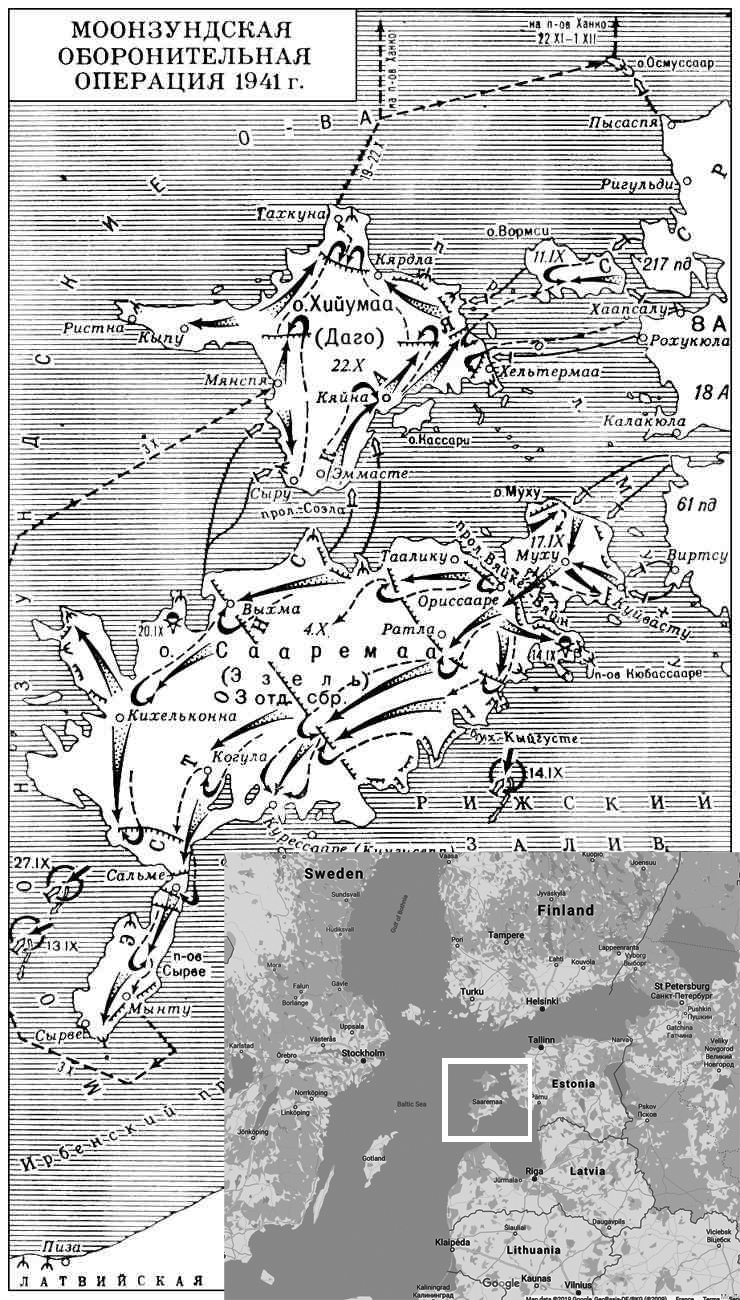
This was a little known Baltic amphibious operation to occupy the islands of Saaremaa, Hiiumaa and Muhu, off the Estonian west coast. The first operation was to be the repeat of the 1917 Operation Albion by the Kaiserliche Marine.
But it was cancelled and the plan was redrawn as Beowulf II. It started on 8 September 1941, securing all objectives 21 October. It started with an attack from the Estonian west coast. It was helped by a serie diversionary attacks to keep the Soviet defenders occupied and bewildered. These limited attacked occurred on Südwind, Westwind and Nordwind, garrisoned by some 23,700 troops, the whole 3rd Rifle Brigade.
The German 61st Infantry Division was reinforced with pioneers and artillery units. They were carried in 100 barges and ferries and 150 smaller assault boats, escorted by small Kriegsmarine ships. However to cover the main landings, there was a joint German and Finnish naval task force, comprising on the German side the light cruisers Emden, Köln and Leipzig. Naval bombardments started on 13 September, assisted by the Finnish coastal battleship Ilmarinen. However the latter hit a mine off Hanko and sank during the operation.
At first, Vormsi was taken on 9 September. The main assault was made on Muhu on 14 September,, and progressed quickly to the neighbouring island of Saaremaa, only connected by a causeway. Muhu was “cleaned up” entirely two days later and a bridgehead secured across the causeway on 17 September.
The 23, Soviet defenders were pushed back to the their local strongpoint, the Sorve Peninsula fortifications. The latter was taken care of by German assault pioneers, closely assisted by an efficient naval gunfire. The last Soviet troops surrendered on 5 October 1941.
Also the Germans landed on the island of Hiiumaa on 12 September and defenders were pushed back to the Takhuna Peninsula. After days of intense fighting, the survivors surrendered on 21 September. The overwhelming factor in this operation has been the uncontested axis naval and air superiority. Soviet losses were heavy, around 4,700 killed and 19,000 captured, for 2,850 on the German side.
Operation Blucher (2 September 1942)
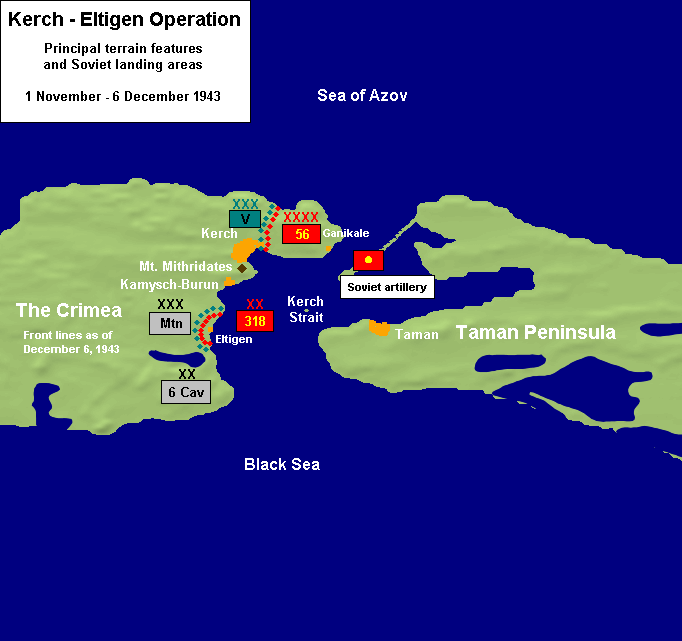
Karch-Eltigen operations (wikimedia cc), the November 1943 landings by the Red Army that started the reconquest of the Taman peninsula and Crimea. Still, this was a German defensive victory.
planned as a five-division attack from the Crimean Peninsula across the Kerch Straits into the Caucasus, as part of Case Blue (‘Fall Blau’). It was executed in a small force, as part of the large southern front summer offensive. The major operation will combine also Italian, Romanian, Hungarian, Slovakian, Croatian elements. In November 1942 however it ended with a failure and trapped troops in Crimea had to be evacuated mostly by the Romanian navy.
Operation BLücher II (another one was planned in 1918 but not executed) was a German landing on the Taman peninsula. It was planned under the responsibility of Generalfeldmarshall Wilhelm List’s Heeresgruppe A. Meanwhile, the 11th Army (Erich von Manstein) had to cross the Strait of Kerch and penetrate into the Kuban, supporting the 17th army (Generaloberst Richard Ruoff) aimed at the oilfields of Maykop and Batumi harbor, on the Black Sea coast.
They face Soviet forces of the Trans-Caucasus Front (General Leytenant Ivan V. Tyulenev). Soon, General Leytenant Fyedor V. Kamkov’s 47th Army was denied any retreat from the Peninsula thanks to the rapid advance of the Romanian 5th and 6th Cavalry Divisions.
Meanwhile, two units of the 17th army, the 46th Division (Generalmajor Ernst Haccius) and XLIX Gebirgskorps (General Rudolf Konrad) were landed on the northern and western sides of the Taman peninsula. They were carried by 24 Marinefährprahme commanded by Korvettenkapitän Max Giele, with the 1st Landungs-Flottille.
Also part of the operation were Siebel ferries, engineer ships and assault boats. They were covered by Korvettenkapitän Arnulf Hölzerkopf. He was in charge of the 3rd Räumboots-Flottille (R-Bootes) and the Luftwaffe. Romanian General Ion Boiteanu’s 3rd Division was to follow and exploit the landings.
While the landings were made with little opposition and progressed well, Soviets forces started their evacuation: Until 5 September, the Soviet navy escorted transports, making the Azov Flotilla (Kontr Admiral Sergei G. Gorchakov). The escort was made of the patrol ship Shtorm and the gunboats Oktyabr and Rostov-na-Donu.
They succeeded in evacuating most of the Soviet army from the south coast of the Taman peninsula. They sailed to Novorossiysk. However the firs day of Operation Blücher, both gunboats were lost in action and the following nights of 2, 3 and 5 September, the 1st Schnellboot-Flottille (Korvettenkapitän Georg-Stuhr Christiansen) rampaged without rest the Soviet embarkation points. They reported 19 kills for the loss of only one boat, when its own torpedo exploded.
This limited amphibious operation, mostly made without much resistance, was a stunning success, allowing to “clean up” and secure the Taman peninsula, in effect controlling the eastern coast and only way to the sea of Azov.
Meanwhile the same day took place the battle of Novorossiysk, in which participated other marine troops, the 14th, 142nd, 83rd and 2nd Naval Infantry Brigades under Rear Admiral Kholostyakov, supported by the heavy destroyer Kharkov and the Soobrazitelny. The city fell on 6 September and the harbour on 9 September, allowing to control the northeastern coast of the black sea.
Operation C3/Herkules (1942)
Probably the second major amphibious combined operation planned by the Germans, it was a massive Axis operation also undertook by the Italian Navy and Army, planned to invade and take Malta, the Mediterranean British stronghold in between Gibraltar and Alexandria which plagued supply operations in the region and impacted the African Campaign.
This was a very ambitious one, with massive paratrooper and glider airborne forces, and Italian landing ships and landing crafts built for the occasion. Notably this included:
-9 Motolance ML
-50 Motozaterra ML
-27 Marinenfahrprahm
-10 Siebel Catamaran Barges
-6 Type 39 and 6 Type 40 Pionerlandunsboote
-281 light Sturmboote and 300 inflatable boats
The Operation, given the rapid successes of the Deutsch Afrika Korps, was postponed and eventually cancelled after the capture of Tobruk as Rommel was fast approaching Alexandria. A full article has been made on the subject, check the link in the title.
The landings at Kos: Unternehmen Eisbär (3-4 October 1943)
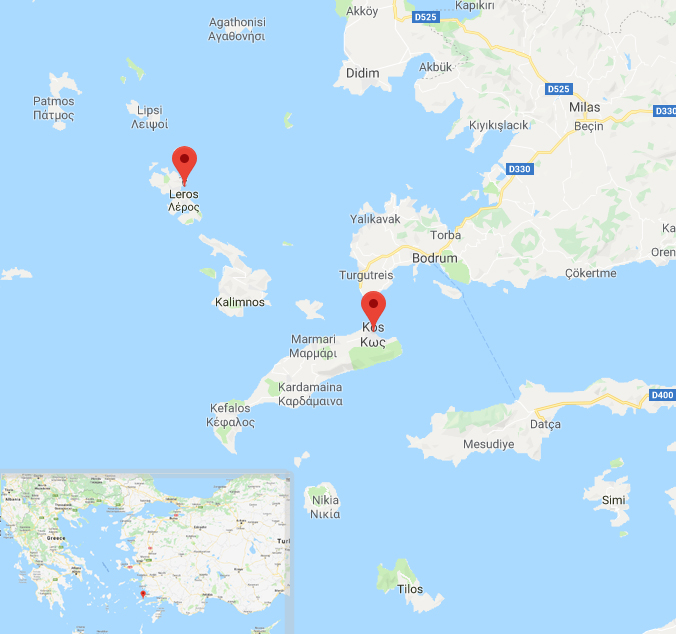
The first German move after the Italian armistice was the swift neutralization of the Italian garrison of Rhodes, by the Sturm-Division Rhodos. On the British side, Kos became rapidly a major RAF base. Here, were stationed troops under command of Lieutenant Colonel L.R.F. Kenyon, some 1,500 men from the 1st Bn Durham Light Infantry and 11th Parachute Battalion, SBS and RAF personnel reinforced by circa 3,500 Italians.
Kos became a prime objective of the German offensive.
Generalleutnant Friedrich-Wilhelm Müller, commander of the 22nd Infantry Division in Crete received orders to take Kos and Leros on 23 September. On 3 October, the first amphibious landing took place, preceded by and airborne landing. This specific operation as called Unternehmen Eisbär or “Operation Polar Bear”. The city was taken within the day and British troops withdrew and later surrendered.
The small German invasion fleet comprised 10 vessels sailing from Crete carrying a Kampfgruppe made of the 22nd Infantry Division and “Brandenburg” special forces, a composite made of Marine troops, the 1st Amphibious Battalion and the 5th Paratrooper Battalion.
The whole task force was under orders of Lt. Gen Friedrich-Wilhelm Müller. The invasion started at 04.30 hours on 3 October and soon a beachhead was established while troops created a perimeter of security. Later after 1 PM, 1,200 troops were landed, together with light artillery and armoured cars, ready for action.
These landings occurred in different places to create diversions: Marmari and Tingachi (north), Camare Bay (south-west), Forbici and Capo Foco (north-east and south-east). Meanwhile on presumed rear lines of the enemy some 1,500 paratroopers were dropped west and south of Antimachia.
To create more disruption another drop happened at 13.30 hours, a single company from the Brandenburg Division. While the Durham Light Infantry, SBS and paratroopers fought gallantly they were soon reduced to a small perimeter of the city of Kos. The Germans pressed the assault, heavily equipped, until the British and Italians surrendered.
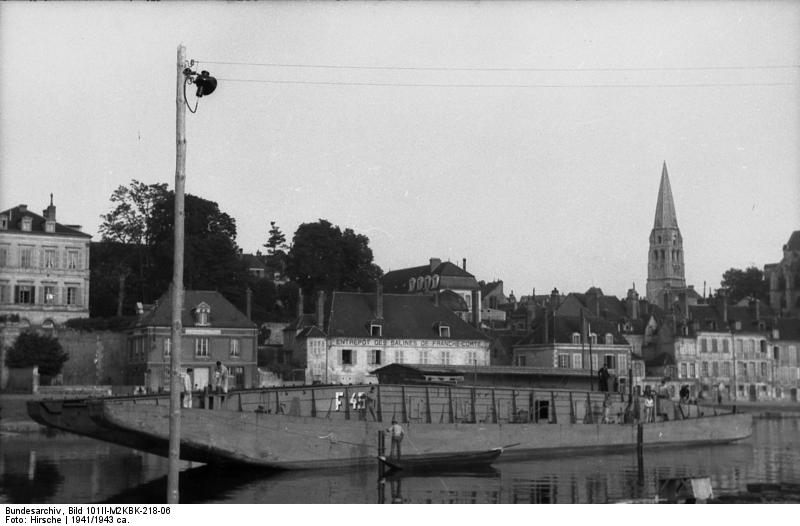
Bundesarchiv – A Landungsboote in France, date unknown, before 1943.
Operation Zitronella (8 September 1943)
The operation also known as Unternehmen Sizilien, was an quick German raid on Spitzbergen, Svalbard Archipelago. It happened on 8 September 1943 under the cover of the battleship Tirpitz and KMS Scharnhorst escorted by nine destroyers.
They shelled Isfjorden, covering the small landing party. In all six Norwegians were killed the rest, 31, were taken prisoner. The Germans from the 349th Grenadier Regiment, 230th Infantry Division only had one dead and a dozen injured.
This small operation which lasted for eight hours was intended to secure a contested strategic asset north of the Norwegian coast, just in the path of the Murmansk convoys. But the archipelago was retaken by the allies on 19 October, with reinforcement bring by the cruiser USS Tuscaloosa.
The operation was a mere political show to Hitler that the surface fleet was still useful. It was also a way to keep the crews busy and trained. In that operation, the landing party was carried by the destroyers and jumped into light boats to join the coast.
Operation Leopard (12 November 1943)
This was an attack of the most strategic British Aegean islands. German forces landed on Leros on 12, captured the Island after four days of heavy fighting. They fought not only the British but also Italian forces which had shifted sides after the armistice (the episode is related in the novel and movie “captain’s corelli mandolin”).
Samos was evacuated on the 20th. In between the Luftwaffe sank four Hunt class vessels, the last two by “missile attacks”, with Hs293 glider bombs. HMS Rockwood off Kos with other destroyers on Kalymnos, never repaired and placed into reserve.
Unternehmen Leopard under command of Generalleutnant Müller was intended to deny the British a strategic foothold near Turkey and close the Dodecanese by basing the Luftwaffe and some S-Boote and R-Boote there. Leros island was previously an Italian heavily fortified base, called “the Corregidor of the Mediterranean” by Mussolini. Italians forces there still had considerable naval forces which loyalty has shifted after the armistice:
-4th Squadriglia Cacciatorpediniere: Destroyer Euro
-III Flottiglia Mas: Two large MS boats and six MAS;
-XXXIX Minesweeper Flotilla (eleven boats)
-9 minor units, 7 merchant ships, 2 minelayers, Azio and Legnano, 3 Italian Marinefährprahm.
-7 CANT Z.501 floatplanes, which can carry torpedoes.
Also there was a Marine garrison, Royal Navy battalion, in total 7,600 men under the command of Captain Luigi Mascherpa. There was also an infantry battalion with MG companies, technical air and AA crew staff.
Facilities for the Navy included fuel tanks, hangars, docks and a drydock, and moreover a well equipped airfield.
In addition, the island was heavily fortified, as said above: Major coastal batteries comprised nineteen 6-in (152 mm) guns, five 4.5 in (102 mm) guns, twenty 3-in (76 mm) guns, 12 AA/DP -fourteen 102 mm, six 90 mm guns- plus 28 3-in (76 mm) AA guns, and an assortment of 37 mm, 20 mm and twin Breda 13.2 mm batteries.
Since the surrender of Italy on 8 September 1943 Winston Churchill’s renewed interest in the Greek Islands (despite the opposition of president FDR), triggered a reaction from both sides: On the British side, a squadron rushed from Malta to land the British 234th Infantry Brigade (Major General F. G. R. Brittorous), taking rapidly the islands of Kos, Kalymnos, Samos, Leros, Symi, and Astypalaia supported by the RAF and the Greek Navy.
Italian troops garrisons there greeted them, either wanting to join them or return home. But the Germans expected this move and were ready.
Waiting for them, the Italians knew the situation was critical.
Instead of obeying ordered and sending their ships to allied bases or at Malta, the Italian commander persuaded the British commander to allow his ships to remain at Leros for the upcoming fight. The British later inspected the AA defences the Italians just reinforced and established a liaison for more efficient joint operations. Still, Major George Jellicoe and Colonel Turbull were dubious about these defences.
The Germans sent a messenger by plane, with a proposition of surrender to the Italians, which flatly refused. Meanwhile reinforcements arrived, Italian troops from Alimia and Rhodes, up to a strength of 8,320 men and 400 more British troops and 600 more with Commander Brittonus on 20 September. At the start of October, British forces amounted to 3,000 men: The 2nd Bat. Royal Irish Fusiliers, the 4th Bat.
The Buffs, 1st Bat. King’s Own Royal Regiment, a company of the 2nd Bn Queen’s Own Royal West Kent Regiment. Air support came from RAF bases in Africa and Cyprus, four Beaufighter squadrons, a Wellington torpedo bomber squadron, three Baltimore, one Hudson and a detachment of Photographic Reconnaissance Spitfires.
The Germans on their side under Generalleutnant Müller mustered the III./Infanterie-Regiment 440, II./IR 16, II./IR 65 (22nd Infantry Division), I./FJR 2 paratroopers, and for what we are concerned, an amphibious commando company of the Brandenburg Division (1./Küstenjägerabteilung).
It was scheduled to start from Kos and Kalymnos. Supplies were airlifted from Athens. The assault close cover was the tasl of two groups of Ju 87 D3 Stukas, I. Group Schlachtgeschwader 3 from Megara, II. Group from Argos and II. Group, Kampfgeschwader 51 (Ju 88 bombers) were also mobilized.
The sea convoy started first but met en route on the 6-7 October, the HMS Sirius and Penelope plus two destroyers. The scene of the disaster was the Astypalaia channel. Troops were lost and their equipments, and therefore delaying the operation.
Meanwhile since a week and a half, from 26 September, until 11 November there was an ongoing Luftwaffe assault of Leros, sinking the Greek destroyer Vasilissa Olga, the British destroyer Intrepid, and Italian MAS 534 in Lakki. About 25% of the AA positions and coastal artillery was eliminated. Naval losses went on in October.
The 3, the Italian destroyer Euro (Partheni bay), and two days later in Lakki, the minelayer Legnano, auxiliary landing ship Porto di Roma, steamer Prode and a MFP landing ship. Later that month this was the turn of MS 15 and MS 26. However the Italian battery on Mt.
Patella claimed eight Stukas. Ammo became scarce and many British and Italian submarines carried 225 tons of supplies, and twelve 40 mm Bofors guns to Leros. British losses at the end of the month were the destroyers HMS Eclipse and HMS Petard, hitting mines.
At last on 12 November 1943 at 4.30 am, the Germans landed. While en route to Gurna bay, six German Marinefährprahme escorted by two ‘Torpedoboote Ausland’ (Italian TBs) and another took place at Pandeli Bay, not far from the city. However the assault comprising six auxiliary gunboats, two armed trawlers, three MFPs, 25 landing crafts was rapidly under heavy fire from the Italian battery 888, sinking two MFPs and damaging other ships.
The landing operations were stopped and the ships retreated, leaving on the sand about 100 men, 85 being made prisoners; Later that day, the Ciano battery on Mount Clido was captured and two MAS scuttled to avoid capture. The Lago battery resisted all night, resorting to very close combat. They were reinforced by an Italian Navy platoon which fought in hand-to-hand combat to reinforced the battery while a reinforcing British company was repulsed by the Germans.
Also later patratroopers from the Brandenburg Division were dropped over Mount Rachi, which they took. On 600, about 300 were killed while the survivors managed to attack the Italan batteries. The 12/13 November night saw more heavy fighting and eventually on 14-15 November, German forces penetrated the city of Leros in multiple points.
With reinforcements from both sides, fallschirmjagers and British troops, the fight was intense, with lines moving back and forth, positions lost and retaken, many prisoners. The Royal Navy was not inactive either. The frigates HMS Penn, Blencathra and Aldenham sunk several German landing crafts while HMS Dulverton was sunk by Stukas.
During the night, the Germans managed to land 1,000 more troops which soon took on the assault of the castle of Leros where the last defenders held firm. Several Italian batteries fell but everywhere, both Italian and British troops fought with great tenacity. But it was hopeless and on the 16 the remnants of the forces, short of ammunitions, surrendered.
This was the last defeat of the British this war. The Italians shown their commitment against the Germans, often refusing to surrender despite their positions were hopeless. It was a kind of ‘Greek Okinawa’ in a sense, which inspired the famous 1957 novel ‘The Guns of Navarone’ of which a classic movie was derived.
Operation Tanne Ost (15 September 1944)
On 2 September, news arrived of a ceasefire between the Soviets and Finnish. Hitler, who feared that, ordered to confiscate all Finnish shipping, preparing also for the Operation Tanne Ost. The latter was also linked to Operation Birke, recovering the German 20th Mountain Army, which was ordered to evacuate. Therefore capturing Hogland became a priority.
A first wave of 1,400 men in landing crafts landed under command of Captain Karl-Conrad Mecke, with companies from the Wehrmacht and Kriegsmarine, from Tallinn. Fight erupted between the Finns and Germans over the docks on the eastern side of the island. In the process, the Finnish TBs VMV 10 and VMV 14 were burned. The Finns had 1,600 men under Ltn-Col Martti Miettinen.
Another landing on the northern part of the island happened, and another, south from the docks, east of the Island, but they were strongly contested with heavy casualties. In addition the Finns soon called for naval reinforcements, the Finnish Navy despatching several Taisto and G5 class motor torpedo boats, which arrived at night around Hogland.
The Germans lost 3 landing crafts, 3 patrol boats, 1 minesweeper and 1 tugboat along with several trucks and halftracks carried. The losses were also due to the attack of 36 Soviet aircraft at noon, mostly 10 Ilyushin Il-2 and 3 Tupolev SB under Flying Major Nikolai Rekolinski. They lost three to AA fire.
All in all, the operation ended in disaster for the Germans. Their forces had to withdrawn from the island, escorted by three destroyers and two large torpedo boats kept in reserve sealed the fate of those still on Hogland. The Finns made 1,231 POWs and inflicted 153 KiA, for the loss of around 75 wounded.
Capturing the nearby Åland Islands (Tanne West), was also planned but never implemented.
About German “Marines”
Unlike many countries with a constituted Navy, Germany in 1939 had indeed Marine companies which were just, like in WW1 regular crews equipped and armed for landing parties. However there were no specialized amphibious assault troops (Amphibienfahrzeugs-Truppen). Operations throughout WW2 were all conducted by units trained for “Spec Ops”.
In early 1939 however, marine artillery units were used as a human pool, picked-up men formed ad hoc landing troops early into the war. Memel was assaulted for example before the war on 23 March 1939 by elements of the III Marineartillerieabteilung, landing and occupying the port and later reinforced the troops deployed at the Westerplatte (Danzig harbour, on September, 1st).
Norway mostly saw paratroopers used instead of marine troops. Landings were improvized by regular troops on small boats carried by cruisers. The Royal Navy took its toll both on the Kriegsmarine and amphibious forces, but Airborne were more successful, further reinforcing their image of elite troops for the HQ and in the eyes of Hitler, whereas the Navy was discredited.
In 1941 the plan to conquer the strategic island of Crete combined an air and amphibious attack. However, again, the Royal Navy intercepted the German convoy and half of the amphibious force was lost and the remnant driven back, leaving only the paratroopers to do the difficult task ahead.
Deprived of heavy equipments like tanks, they did well and eventually won, but at great cost. Crete was considered a pyrrhic victory. Lessons from the Norwegian campaign would be precious in writing detailed plans for the invasion of the British Isles as well as the Cretan campaign.
However operation Sealion was conditioned by the destruction of the RAF, as the Royal Navy could be dealt with the Luftwaffe afterwards.
The outcome of the battle of Britain make German strategist shift their attention to the Mediterranean again. In 1942 the Kriegsmarine started to create marine land units made from a pool excess reservists and used like normal land units, but with a limited infantry training and same uniforms with the exception of field grey buttons showing an anchor, as the same field equipment except for a golden belt buckle and redesigned shoulder boards. These were certainly not elites, and their ranks was made towards the end of the war with mostly idle crews, without ships (either in reserve, repairs or sunk). Their major feat of arms was in the defence of Holland during operation Market-Garden. Over 2000 “Marines” fought the British at Arnhem, in cohesive units with added regular Heer (standard infantry) and in some case SS NCOs which drilled them in street fighting.
Barges of Operation Sealion (1940)
In prevision fo the operation, German authorities confiscated some 2,400 barges from throughout Europe: 860 came from Germany (as not further would impact national production and supplies), but the bulk came from the Netherlands (1,200) and Belgium, and only 350 from France. Apparently only a fraction of the French barges, as to not either hamper the German occupying forces of northern France.
From this pool, it was possible to devise landing crafts with some transformations. In the end, their poor conditions and weak engines made only 800 suitable, which wee to be towed at that to shore. So the operation needed in addition some 400 tugs, with two barges towed abreast, including one not powered.
The powered ones untowed for the last kilometers before the shore and beaching while the unpowered ones were towed close to shore and left beached waiting for the low tide to disembark their payload.
For beach ‘E’, which was over deeper depths, it was required a feeding system to shore, disembarking equipments via smaller ships. The whole operations of three echelons would have taken 14 hours, in flat sea conditions.
Type A Barges
To make barges out for this pool, the Germans separated them into A1 and A2 types: The ‘peniche’ standard was 38.5 meters long, carrying 360 tons of cargo and the ‘Kampine’ 50 meters long and carrying 620 tons of cargo, respectively 1,336 and 982 were eventually collected. Work started as soon as manpower and equipments was available to convert the first 170, but the task at hand was daunting: Each of these barges were to be modified along similar ways:
-Cutting an opening in the bow to off-load troops and vehicles
-Welding longitudinal I-beams and transverse braces (for strength and seaworthiness)
-Adding a wooden internal ramp for fast unloading
-Pouring a concrete floor in the hold (to allow for tank and artillery transport).
A1 barge carried three medium tanks (Panzer III type) and A2 could carry four, potentially also the Panzer IV. Open barges were also intended to serve as shuttles, feeders to larger ships, anchored far from the beaches.
Type B Barges
These were basically the same barges, but modified to carry submersible tanks such as the Tauchpanzer. They could unload these far from shore, at around 15 metres (49 ft) in depth, so less vulnerable to enemy fire than the A type barges. They were to receive a longer external ramp of 11 meters, ending with a large float.
It was anchored and the first tank rolling forward onto the ramp would naturally tilt the forward end into the water, pushing it downwards to the sea. The ramp then was to bob back, ready for the next tank. The same system could be used also for the Schwimmpanzers. 70 were ordered and 5 more on 30 September.
Type C Barges
A derivative intended to carry the Schwimmpanzers. A large hatch was cut into the stern to allow passage of the tank and its floats. These were Barges of the Type A2, each carrying four Schwimmpanzern in the hold. 14 have been modified by the end of September 1940.
Type AS Barges
These were tailored assault barges made for carrying advanced infantry detachments, dropped at sea with their weak inflatable speedboats, carrying ten assault boats (Sturmboote).
Their sides were filled with concrete for extra protection but this made them heavier and slower. Their duty was to protect as long as possible for shell splinter and machine gun fire the assault troops. 18 of these barges were ready by the end of September.
Type AF Barges
Like the ‘Siebel barges’, these were Luftwaffe’s own experiments and contribution to Operation Sealion (Sonderkommando Fritz Siebel). These were unpowered A barges powered by a pair of surplus 600 hp (610 PS; 450 kW) BMW aircraft engines, acting on the shafts. The Heer was enthusiastic about the idea and ordered some.
Both aircraft engines were mounted on scaffolding-supported platforms on the bridge aft for air cooling. Salty water splashes were not taken in consideration as the crossing was relatively short. In October 1940, 200 has been so converted. They were used by the Kriegsmarine later to assault Baltic islands in 1941.
Marinefahrprahm (1940)

Src: weaponsandwarfare
The Marinefährprahm or MFP for “naval ferry barge”, was the largest landing craft used during ww2 by the Kriegsmarine. It was developed from a pontoon, but tailored as a common barge, the type of which roamed the numerous canals and rivers of Europe. This faculty allowed the Marinefahrprahm to operate anywhere in Europe, not only as an amphibious craft but also as a transport by seaways, alternative to rail.
The 700 originally created for Operation Sealion (July 1940) -the first was commissioned on 16 April 1941- were declined to the subclasses: A-D, MZ, AF, AT, KF, some heavily armed and acting as FLAK ships. In fact the allies called them “Flak-ships”, or support ships.
The very first prototype called all-welded construction, but the following were all riveted to spare skilled labour. The prototype also was to use 600 hp 6-cylinder surplus BMW aircraft engines and a truck Deutz engine, for 13 knots total, but the first proved fuel-hungry and troublesome and n the end only truck engines were used, all diesels and reliable.
The three engines gave 390HP for 8 to 10.5 knots (empty) but allowed for a much larger range of 1340nm at 7kn, simplified maintenance and supply.
The standard version was the type A, which could carry 85 up to 140t. A Type with a much reinforced hull was built for Operation Herkules, with a reinforced bottom. This was to carry captured and modified support tanks such as KV-1 or KV-2 heavy tanks. This required to strengthen and make wider the well decks and internal ramps. The bow ramp was repositioned further forward to counterbalance weights in order to accommodate these vehicles. After the Type A the serie was declined into the B, C and D with minor variants.
The other variants were the Artilleriefährprahm (AFP) a gunboat fitted with two 88mm guns and light AA guns, the Italian-built Motozattera (see later), the AF, AT, and KF types which will be seen in detail on dedicated posts. The Marinefährprahm was extensively used during Operation Barbarossa, starting with Operation Beowulf II, the invasion of Saaremaa, Hiiumaa and Muhu islands in the Finnish baltic on 14 September 1941.
They were active also during the siege of Sevastopol, seen in action in the Kerch Strait and Taman Peninsula (Operation Blücher II), or evacuating the 17th Army from Kuban. From February 1944, three of these barges were also manned and operated by the Romanian Navy, which previously took a key role in the evacuation.
Marine Nachschub Leichter (1943)

Author’s illustration of the MNL, with a SdKfz-7 FLAK and 8×8 SdKfz 231; The rear FLAK gun is a 3,7 cm one.
This smaller Naval Supply Lighter compared to the previous AMP called Marine Nachschub Leichter or MNL was intended for rivers, long after Operation Sealion. These were designed in 1943/44, with close dimensions to fit southern France canals width, now occupied, to transfer troops and material to the Mediterranean, avoiding train sabotage and resistance actions.
However when they went operational, the allies had already landed in Normandy and Italy. This did not prevented them to serve anyway in rivers as intended and coastal areas as well, notably in the Mediterranean.
The MNL were riverine supply ships and landing craft, lightly armed. 32 in all were built identified MNL 1-32. They did not have a landing rap and therefore were ill-suited for fast landing operations.
Their main task was to supply areas deprived of docks and facilities along a river close to the frontline. Remarkably, they were made of six individual 18-ton sections, transported by rail and assembled in 1-2 days. Power came from standard diesel diesels, producing a combined 240 hp. The control bridge was in the stern.
Top speed was around 10 knots or 18.5 kph for 540 nautical mimes or about 1000 km inland. The 3.7 cm flak defended the rear while the 2 cm Flak Vierling 38 was placed on the bridge’s roof.
Their initial design came from the intended crossing of waterways of France to the Mediterranean the so-called “Freycinet gauge” of French canals and locks. But as situation changed rapidly this became irrelevant. Each of these had two internal low cargo holds about 1.6 m high, but weather-protected.
However vehicles, artillery and heavy equipment could be transported on the deck, but limited for stability reasons to 20 tons. A single removable 2 tonne loading boom was also carried on board for loading and unloading operations, helped by two entrained track carriers.
See in 3D and high definition (Marco Gurk)
A successor type was called naval pursuing type II. This time, without restrictions in size but the development was discontinued in early 1944. It was made of 15 sections and this time had a true landing ramp. Propelled by three diesels it could carry up to 125 tonnes at sea and up to 175 tonnes. None was completed.
Specifications:
Displacement: 216 t, Size: 38 m x 5 m x 1,3 m
Payload: 90 t, Crew: 9-14
Armament: one 3,7 cm, one 2 cm FLAK
Power: 4 truck diesel engines, 2 shafts, 250 shp, 10 knots and range 560 miles at 10 kn
Marine Artillerieleichter (1943)

Author’s illustration of the Marine Artillerieleichter
These were even smaller landing crafts made originally for Operation Barbarossa, 35 meters and mostly intended to operate on the Caspian sea during operations against Soviet reinforcement between Baku to Astrakhan, transported by rail.
The Marine Artillery Lighters (MAL) of the Kriegsmarine were flat pontoon-type landing craft. They did not possessed an hold and had no loading ramp either. Loading was carried out by manually cranked loading tracks and was a long process. These vessels were self-propelled, riverine, and performed general supply tasks near the front.
In USSR during the exploitation phase of Operation Barbarossa deep into enemy territory, the German Army Command was faced with the lack maritime transport capacity in the Caspian Sea and Sea of Azov. Boats needed to be constructed in Germany in sections to be carried over land to be assembled in situ easily without much equipments with little training. The MAL also called Artilleriemotorleichter was developed in Krupp works, Rheinhausen. By September 1942, the first twelve ships were completed and carried by rail for operations.
They proved disappointing and in 1943 an enlarged serie of 12 ships was created. They had a larger deckhouse, and a hinged bulwark in the bow for seaworthiness. Later an enlarged version with increased control station and side bulwarks, higher bow was also ordered, called MAL II, as the previous ones were called MAL I and MAL Ia. About 60 ships of this type were eventually assembled, intended for the Mediterranean and Baltic Seas.
The MAL were prefabricated in ten modules. They could be transported both by rail and truck. Each was loaded on a rail two-axle open freight car while wagons carried the armament, engines and other equipment. Parts weighted less than 18 tons. They could be assembled on site within two days. The work was simple, just connecting them with simple drawbar couplings and pouring in the joints and bulwark some concrete. The bridge was the 10th segment.
Armament varied. The main was made of two WW1-vintage 88 mm SK C/35 guns, and two Flakvierling quad mounts 2 cm installed on the bridge’s roof, but 3.7 cm flak were also used. Total carrying capacity was 80 t, 200 men with equipment or two heavy trucks, five to six trucks when the 88 mm guns were landed. These MAL could also carry two Panzer-III/IV tanks.
The MAL started its career in April-May 1943 in the Black Sea, when the first 8 were assembled and used from Sevastopol. From June to October they carried supplies in the Azov Sea. They were however criticized as poor seagoing boats. Bad weather claimed MAL 8 on the 1st of September 1943 in the sea of Azov, MAL 2 and MAL 4 were were so badly damaged they had to return to Sevastopol for repairs.
These two ships were sunk in front of Varna in August 1944 by their own crews. The remaining five remained in the Sea of Azov and evacuated of German troops from the Kuban bridgehead. They were scuttled on October 29, 1943.
Known specs:
Displacement 140 t
Size (Max) 34,60 m, beam 8,60 m or 7.72 m, draft of 0.87 m
Power: Two Deutz Diesels (2x 130 hp). Top speed 8.5 Kn, range of 790 nm
Crew: 21+29 (weaponry)
Armament: 2x 8.8 cm SK C/35 (upper deck), 2x 20 mm flak (wheelhouse), MG-34/42, see notes.
German Siebelfähre (Siebel Catamaran barge)
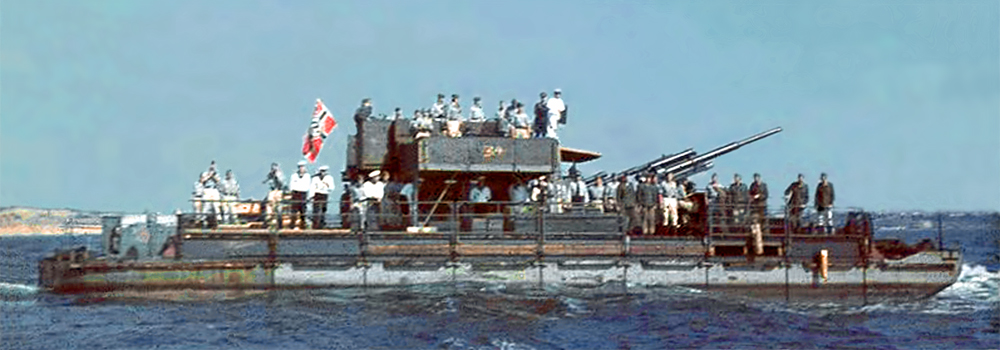
Bundesarchiv: Siebelfähre_mit 8,8 cm Flak in the Black Sea – 3D HD of the Schwere Fähre 40 ohne Deckhaus Reconstitution by Marco Gurk
The Siebel Barge was the versatile shallow-draft catamaran landing craft of the Wehrmacht during the war. They were developed originally for Operation Sea Lion in 1940, but whan it was cancelled, they were nevertheless used in many theaters of operations.
With their modular construction and standardized parts thay could be disassembled and transported by rail anywhere. The idea was Field Marshal Walther von Brauchitsch’s ad it was designed by an aircraft engineer, Luftwaffe colonel Fritz Siebel. He built the first prototypes with what he could scavenger at Carteret (western Cotentin Peninsula).
He experimented many powered rafts based on wine-barrels, tree trunks, kapok-filled sacks and ship’s canvas and played around with the already 300+ existing and now useless schwere Schiffsbrücke (heavy pontoons) using during the western campaign. He ended with a catamaran arrangement connected by steel cross-beams and powered by three surplus aircraft engines like the BMW 6U 750 hp, or in alternative 75 hp Ford V8 engines.
Production started in September 1940 at Antwerp with the Böndel Pionier-Sonderkommando assembling them for Operation Sealion, also with FLAK-ships to cover the crossing, creating the Flakkorps I and II carrying one 8.8 cm gun and two 2 cm guns with their own prime movers, the idea was these units would then carry on their duty on land.
After Sealion was cancelled, the Special Ferry Command (Fähre-Sonderkommando) went on with the Luftwaffe (not the army), using aicraft engines. Whereas the army’s model were converted to many other uses, on lakes and rivers or shallow waters, and in surprising roles by the Navy such as minelaying to convoy escort.
This was indeed one of the rare “vehicles” to be used by all three arms. The Luftwaffe also used them on Lake Ladoga (Einsatzstab Fähre Ost) during the siege of Leningrad and of course ten were provisioned for the landings at Malta. In all, 42 were lost during the war, the production reaching about 200 units.
SPECIFICATIONS
-Displacement: 140–170t
-Size: 32 m (105 ft) x 15 m (49 ft) x 1.8 m (5 ft 11 in) draught and 1.5 m (4 ft 11 in)
-Propelled by: 4 Ford V8 300 HP= 11 kn (13 mph; 20 km/h)
-Range: 300 nautical miles (560 km; 350 mi)
-Carrying capacity: 50–100t cargo or vehicles
-Crew 11–14
-Armed by: Up to 4 x 8.8 cm guns FLAK, one 2cm Flakvierling 38 or two 2cm FlaK 30.
Pionierlandungsboot 39, 40 & 41

Bundesarchiv – Landungsboot mit Zugkraftwagen
Since the Wehrmacht had no modern ferries or dedicated landing barges in 1939, especially for tanks, such vessels were developed. The waffenamt contacted several companies and the biodding saw one winner, the prototype of Bodan shipyard in Kressbronn, on Lake Constance, where Zeppeling airships were born.
Called the Pionierlandungsboot 39, the first model came into mass production in mid-1940 and was accepted for service and deployed operationally in September 1940. Soldiers quickly went to call it the ‘Pilabo’, followed by the mark. The Pilabo 39 was large enough for tanks and therefore could be assembled in two halves, each one laid on a standard railway platform.
The model 39 measured 15 m in lenght by 4.7 m wide assembled. It was propelled by two 86 hp diesel engines, making for a top speed of 20 km/h. It weighted 20 tons empty but can carry the same weight in payload and was quite stable.

Author’s illustration of the PilaBo 39 carrying an Opel Maultier
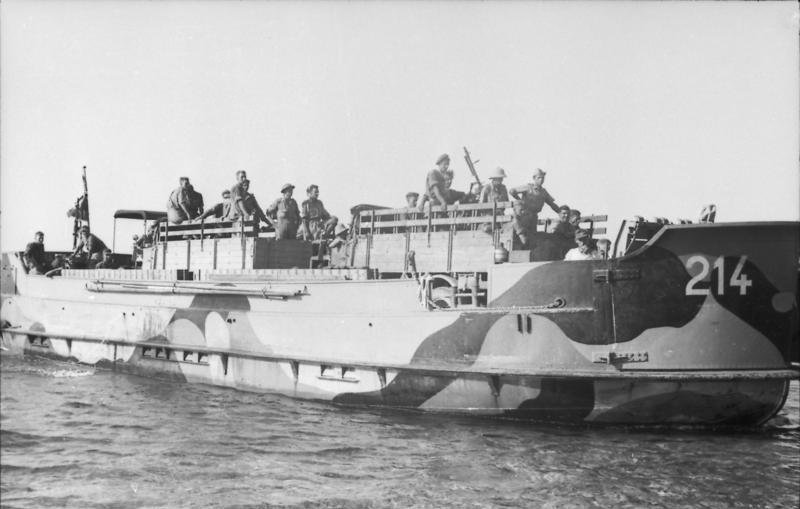
Pilabo 39 #214, camouflaged in the Mediterranean, circa 1943 (Bundesarchiv).
The Pilabo 40 followed with the same engine layout and assembly in halves but larger dimensions at 19 m by 5.93 m wide. It weighted 30 tons.
From there and operational service lessons, an improved version was soon ordered. The Pilabo 41 was designed and built in 1942. It was only marginally larger at 19.3 m by 5.93 m wide, weighted 35 tonnes but was powered by two 120 hp engines allowing 8 knots.
The smaller engines freed some space while the reinforced structure allowed to carry up to 40 tons. Contraty to previous practive of a bow opened in two, and transition rails deployed, which slowed sown the process, the Pilabo 41 had a simpler bow ramp, like allied crafts.
The last in line was the PilaBo 43, much enlarged. The lenght was rised to 35.5 m long, for 8.60 m wide, and a displacement of 145 tons for 95 tons of payload, on a 230 m² loading area. It was armed on the starboard side forward by a light Flak gun. It was still disassembled, but this time in three pontoon modules to be carried by rail.
These were carried on the ‘Landungsbootzügen’ trains. The train arrived in March 1941 in the Baltic, carried to the start point of the Pomeranian island of Wollin.
First military use was made in May 1941 on the North African coast for the German Afrika Korps. But soon they were deployed in the Black Sea, Mediterranean, Norway, France and the Baltic.
At the end of the Second World War, Pilabos were the saving grace for scores of civilians escaping before the Red Army. One of these refugee transports of company Hannibal, a Pilabo 41, made so many trips back and forth, saving thousands that a memorial has been erected for it on the Oberschleißheim airfield in Bavaria.
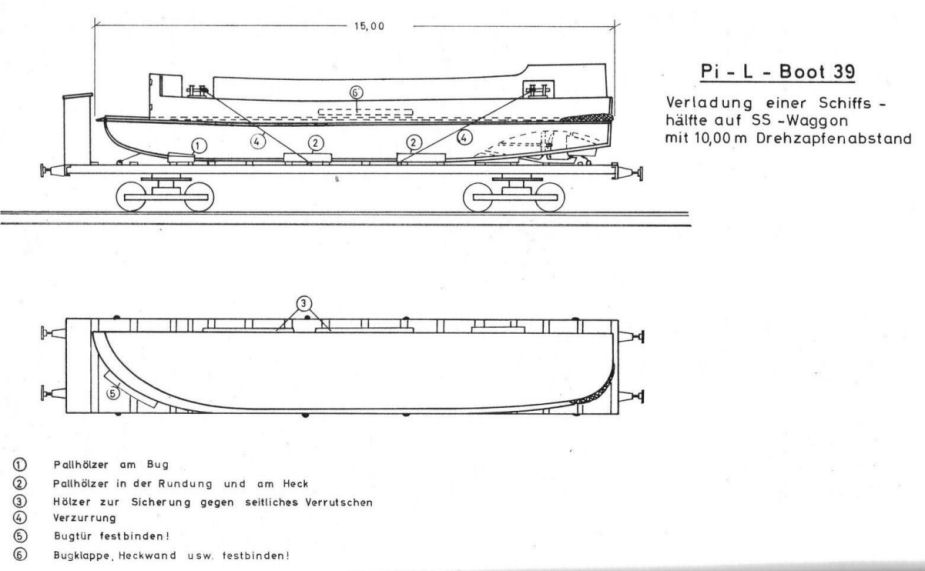
Blueprint of the Pionierlandungsboot 39 and rail carriage src:http://www.lexikon-der-wehrmacht.de/
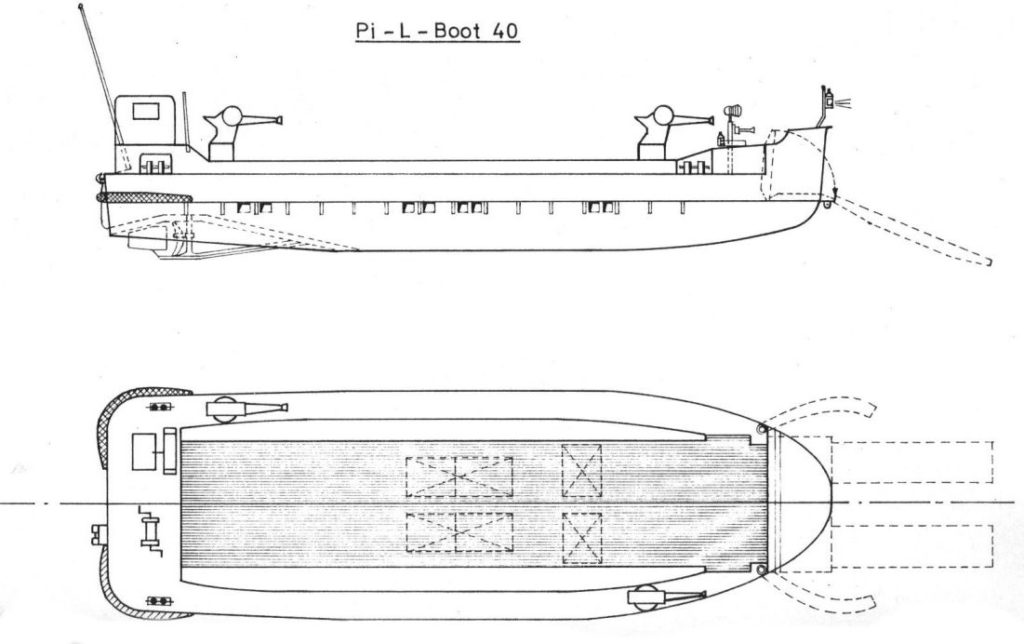
Blueprint, 2 views of the Pionierlandungsboot 40 src:http://www.lexikon-der-wehrmacht.de/
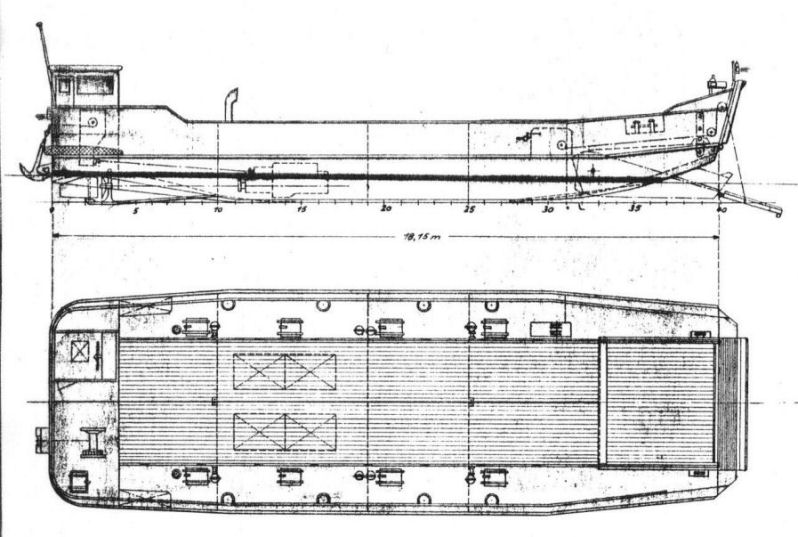
Blueprint, 2 views of the Pionierlandungsboot 41 src:http://www.lexikon-der-wehrmacht.de/
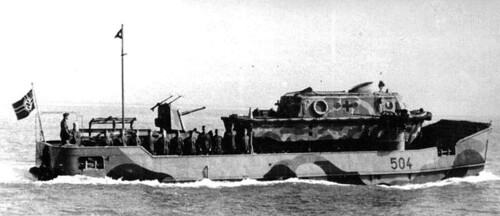
Camouflaged Plsbt 39 carrying a Landwasserschlepper – Flickr, Fluidr.com

Camouflaged Plsbt 40/5 -src www.panzer-bau.de
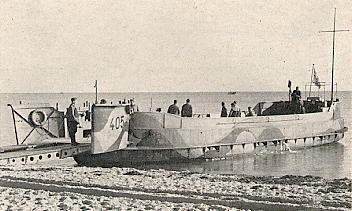
Pionierlandungsboot PiLB 405 -src Militaar.net
Sturmboote
The Leichtes Sturmboot 39 was essentially a small but high-powered assault craft with an outboard motor extended from the rear of the craft. It was used for fast river and waterway crossings (30 mph) but also security and anti-partisan patrols. The Sturmboot 39 made for Operation Barbarossa could carry 6 men, one using a bow-fitted MG42. But this light craft was made of wood in foldable panels for easy transport by truck and rail and offered no protection.
Transport Hydrofoil VS 8
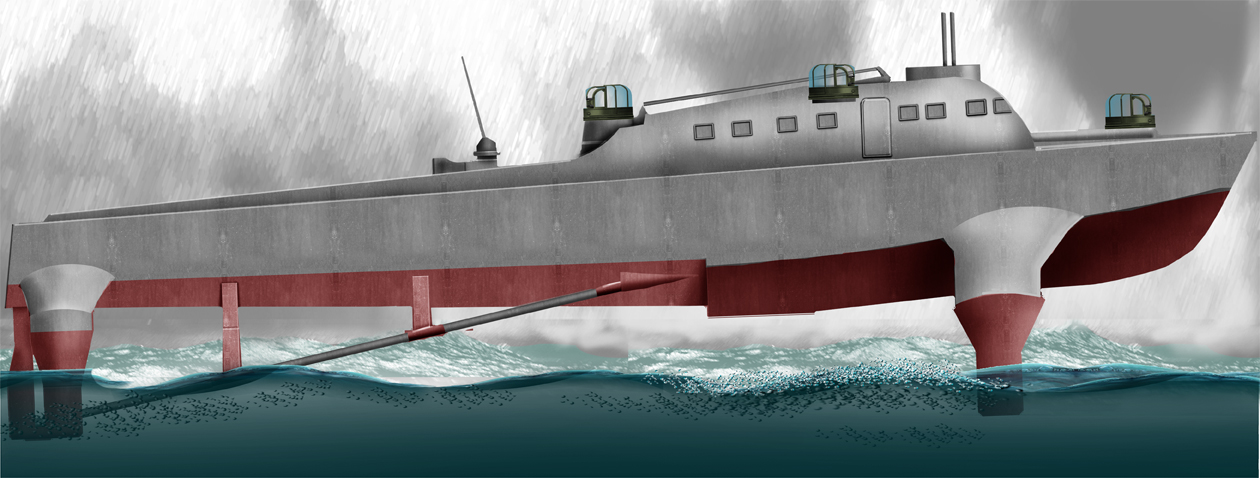
Author’s reconstruction of the VS-8 in full speed trials.
Certainly the most modern of all the amphibious crafts designed for the kriegsmarine, the large VS-8 were part of the German hydrofoil development line already seen on the Manta project. It could carry at great speed and land by the stern, flooded, a light tank Type 38T up to a Panzer IV, but trials from 01.03.1943 proved it was underpowered and later the prototype was tested as fast minelayer for the channel, but it was lost on September 1944 and work on the second prototype VS-9 was abandoned. Needless to say this fascinating prototype will be detailed later in a dedicated post.
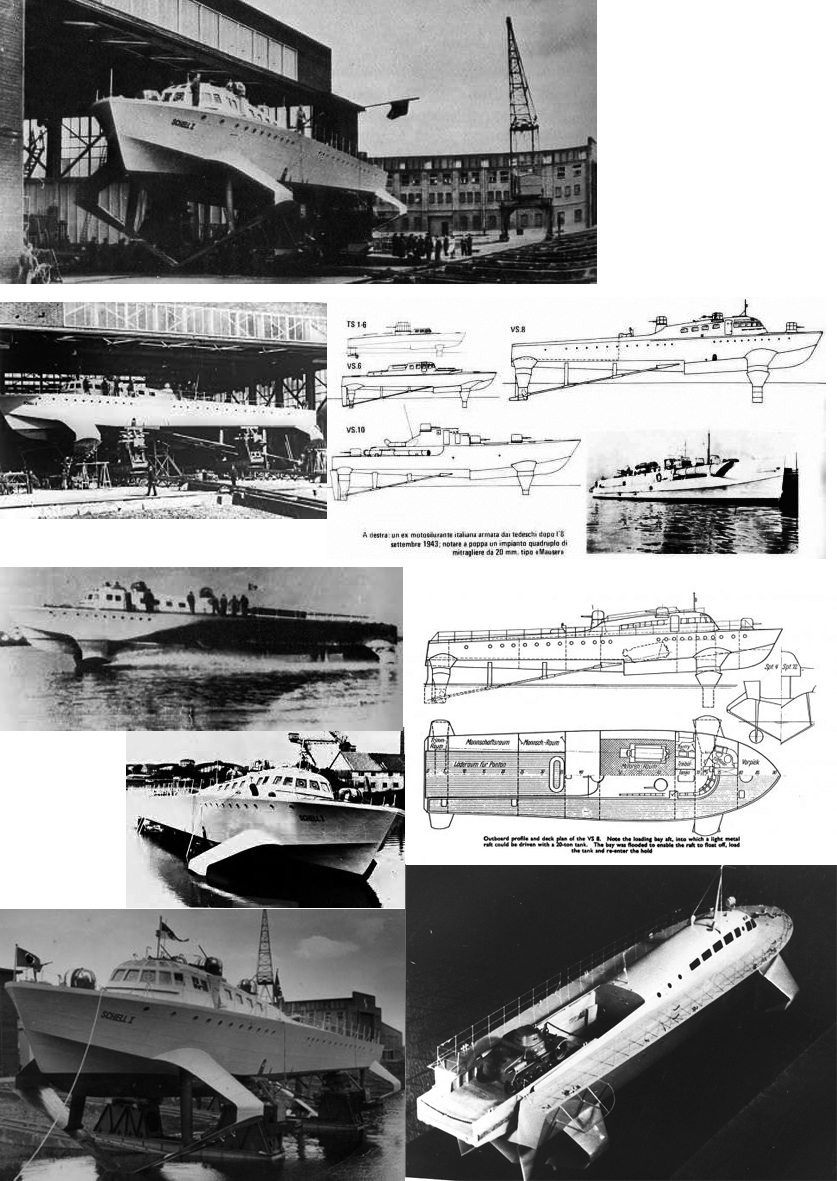
A mix of photos and blueprints from the web (main reference in the readmore below)
Vehicles
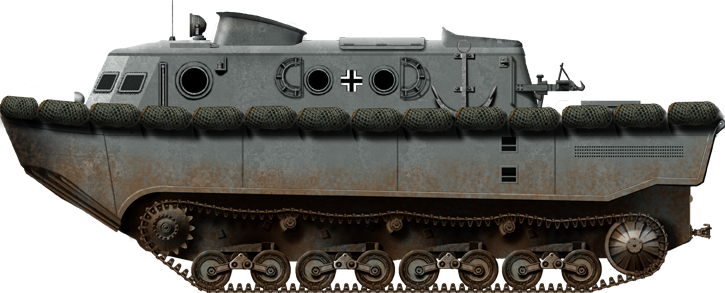
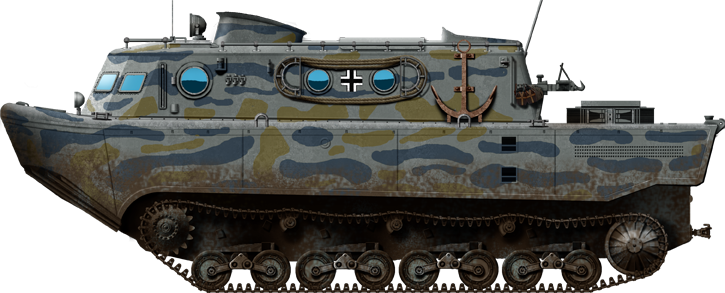
Landwasserschlepper, in Grey livery and camouflaged. Both illustrations made by the author of Tanks Encyclopedia.
Although not a ship, but a tracked vehicle, the Landwasserschlepper could have been also deployed during the invasion of Malta. It was unarmed and unarmored, and only a few were built from 1942.
The idea was to carry them into a dock ship which could be flooded and release these vehicles near the coast. The same idea was already tinkered with in 1940 for Operation Sealion, with modified Panzer-IIIs called Tauchpanzer, released at 20 km for the coast.
Italian landing crafts
Motolance ML

Author’s rendition of the profile of the ML.
In the autumn of 1941, the Regia Marina ordered the construction of 100 wooden motor landing boats in preparation of the invasion of Malta. The first, and only units launched in the spring of 1942, were from the Cantieri Navali Moncalvi & O.M.S.A. (Pavia), denominated ML 654 to ML 662, nine ships in all. Each one carried 9 crew members, 30 equipped soldiers in a central open “tub” with a forward ramp.
They were transferred on the Po, joined the Adriatic, and made it via the Strait of Messina into the Tyrrhenian Sea, in Gaeta harbor. In the late summer 1942 they were transferred to Livorno, assigned to the Maritime department of the Upper Tyrrhenian sea, inside the 3rd Flotilla and two Squadrons (Pavia and Voghera).
On 10 November 1942, they were first used to invade Corsica, carrying the “San Marco” Regiment alongside 137 other naval units, in a little known amphibios operation of WW2. They landed in Bastia on 11 November 1942, and were back the folloing day in Livorno. The lack of documentation make it difficult to assert their use afterwards.
They could have assisted the Motozattere on the so-called “route of death” within the minefields laid up between Italy and Tunisia, or served between Sardinia and Corsica or possibly in and out of Provence until Italy capitulated.
None survived the war and documentation is scarce, with only 3 photographs but no blueprints.
More about the Motolance ML:
Following the landing in Corsica, the most plausible hypotheses on operational use are:
-Transport of troops and materials, in convoy with 239-ton motor rafts, on the so-called “route of death”, that is the obligatory route between minefields between Italy and Tunisia;
-Transport of troops and materials between Sardinia and Corsica;
-Transport of troops and materials in Provence (until 8 September 1943).
None of the 9 motor boats of the 3rd Flotilla remained operational at the end of the war. There are only 3 photographs that portray them and no drawings, which makes all recreation difficult. Builder: Moncalvi (Pavia) and O.M.S.A. (Pavia), all Completed by spring 1942
General features:
Displacement 15.5 tonnes, overall length 14 m
Propulsion: 2 Diesel engines, top speed 12 knots (22.22 kph)
Crew: 9 + 30 equipped soldiers
Armament: Single 13.2mm machine gun in the bow
Motozaterra MZ
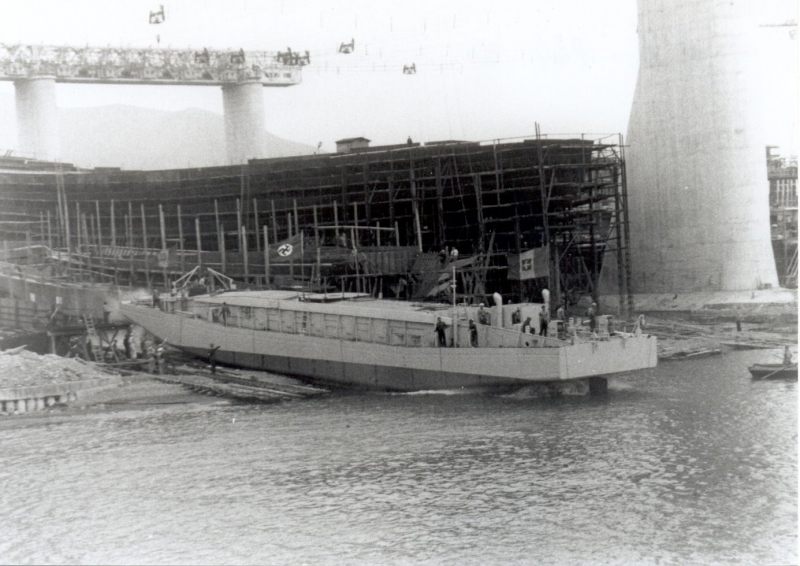
Motozaterra ML launch in 1942 credits: www.naviearmatori.net
The Italian version of the Marinefahrpram, this ship’s only puspose was the invasion of Malta, Operazione C3. The Regia Marina was given blueprints of the the Type A in late 1941. The first order was forr 65 barges (701-765).
They were called “Motozattere” (Bette MZ) in Italian shipyards of Palermo and were the first dedicated amphibious ships of that type in service with the Italian Navy. They could easily handle troops, armored vehicles and supplies, carrying for example three M13/40 medium tanks and 100 infantrymen.
The Italian version however used local truck engines, OM BXD 150 hp six-cylinder (same as for the Littorina diesel trains). Their main armament was a 3 in (76 mm)/40 QF Breda gun.
Work started in March 1942 and by July all 65 MZs had been completed, ready for the Malta invasion, which was postponed on 27 July. Therefore MZs were ferrying supplies to Libya insteed as well as along the Libyan coast, providing a precious shallow water support to the Afrika Korps. Thanks to these, the Axis was able to be resupplied anywhere on the coast rather than in the few ports available, a crucial advantage.
In September 1942, the success of the formula pushed the Italian admiralty to order more, and 40 MZs numbereed 761-800 followed, with modifications such as a raised bow to improve seaworthiness and strengthened keel.
They also had larger fuel tanks for better range and 100mm thick concrete armor plus a second Breda 20mm AA gun mounted amidships. The third serie (40 more MZs) ordered in June 1943 was never completed as well as 20 derivatived numbered MZ 801-820 based on the German support barge MFP-D. When the armistice came in September 1943, 95 Motozaterra has been delivered.

Italian Motozaterra by the author.
Read More/Src
https://www.naval-history.net/WW2CampaignsAmphibious.htm
https://historisches-marinearchiv.de/
https://en.wikipedia.org/wiki/Operation_Beowulf
http://www.harhaus.de/hmneuheiten2003.htm
https://codenames.info/operation/blucher-vi/
Randolf Kugler: Das Landungswesen in Deutschland seit 1900
Pionierlandungsboote im Historischen Marinearchiv
https://de.wikipedia.org/wiki/Pionierlandungsboot
https://www.naval-history.net/WW2CampaignsAmphibious.htm
https://www.german-navy.de/kriegsmarine/ships/landingcrafts/index.html
Statistical analysis – Operations organization and statistics, military simulation
My Tank is Fight! on the VS8
Pics of the PilaBo 40 and 41:
//st2.barrageminiatures.com/1396-thickbox_default/second-world-war-german-pionierlandungsboot-39-156-28mm.jpg
Pionerslandungsboote 39
//st1.barrageminiatures.com/1407-thickbox_default/second-world-war-german-pionierlandungsboot-41-156-28mm.jpg>
Pionerslandungsboote 41


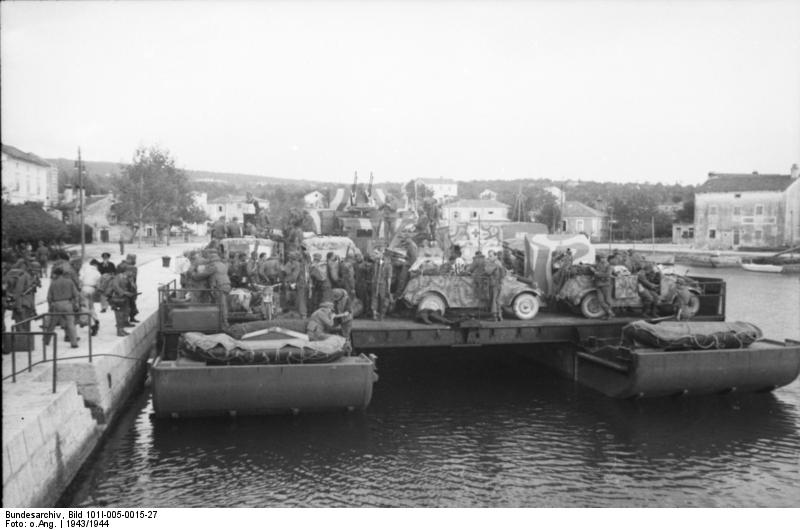
 Latest Facebook Entry -
Latest Facebook Entry -  X(Tweeter) Naval Encyclopedia's deck archive
X(Tweeter) Naval Encyclopedia's deck archive Instagram (@navalencyc)
Instagram (@navalencyc)





 French Navy
French Navy Royal Navy
Royal Navy Russian Navy
Russian Navy Armada Espanola
Armada Espanola Austrian Navy
Austrian Navy K.u.K. Kriegsmarine
K.u.K. Kriegsmarine Dansk Marine
Dansk Marine Nautiko Hellenon
Nautiko Hellenon Koninklije Marine 1870
Koninklije Marine 1870 Marinha do Brasil
Marinha do Brasil Osmanlı Donanması
Osmanlı Donanması Marina Do Peru
Marina Do Peru Marinha do Portugal
Marinha do Portugal Regia Marina 1870
Regia Marina 1870 Nihhon Kaigun 1870
Nihhon Kaigun 1870 Preußische Marine 1870
Preußische Marine 1870 Russkiy Flot 1870
Russkiy Flot 1870 Svenska marinen
Svenska marinen Søværnet
Søværnet Union Navy
Union Navy Confederate Navy
Confederate Navy Armada de Argentina
Armada de Argentina Imperial Chinese Navy
Imperial Chinese Navy Marinha do Portugal
Marinha do Portugal Mexico
Mexico Kaiserliche Marine
Kaiserliche Marine 1898 US Navy
1898 US Navy Sovietskiy Flot
Sovietskiy Flot Royal Canadian Navy
Royal Canadian Navy Royal Australian Navy
Royal Australian Navy RNZN Fleet
RNZN Fleet Chinese Navy 1937
Chinese Navy 1937 Kriegsmarine
Kriegsmarine Chilean Navy
Chilean Navy Danish Navy
Danish Navy Finnish Navy
Finnish Navy Hellenic Navy
Hellenic Navy Polish Navy
Polish Navy Romanian Navy
Romanian Navy Turkish Navy
Turkish Navy Royal Yugoslav Navy
Royal Yugoslav Navy Royal Thai Navy
Royal Thai Navy Minor Navies
Minor Navies Albania
Albania Austria
Austria Belgium
Belgium Columbia
Columbia Costa Rica
Costa Rica Cuba
Cuba Czechoslovakia
Czechoslovakia Dominican Republic
Dominican Republic Haiti
Haiti Hungary
Hungary Honduras
Honduras Estonia
Estonia Iceland
Iceland Eire
Eire Equador
Equador Iran
Iran Iraq
Iraq Latvia
Latvia Liberia
Liberia Lithuania
Lithuania Mandchukuo
Mandchukuo Morocco
Morocco Nicaragua
Nicaragua Persia
Persia San Salvador
San Salvador Sarawak
Sarawak Uruguay
Uruguay Venezuela
Venezuela Zanzibar
Zanzibar Warsaw Pact Navies
Warsaw Pact Navies Bulgaria
Bulgaria Hungary
Hungary

 Bundesmarine
Bundesmarine Dutch Navy
Dutch Navy Hellenic Navy
Hellenic Navy Marina Militare
Marina Militare Yugoslav Navy
Yugoslav Navy Chinese Navy
Chinese Navy Indian Navy
Indian Navy Indonesian Navy
Indonesian Navy JMSDF
JMSDF North Korean Navy
North Korean Navy Pakistani Navy
Pakistani Navy Philippines Navy
Philippines Navy ROKN
ROKN Rep. of Singapore Navy
Rep. of Singapore Navy Taiwanese Navy
Taiwanese Navy IDF Navy
IDF Navy Saudi Navy
Saudi Navy Royal New Zealand Navy
Royal New Zealand Navy Egyptian Navy
Egyptian Navy South African Navy
South African Navy






























 Ukrainian Navy
Ukrainian Navy dbodesign
dbodesign
Dear Reader,
I’m looking for a special kind of vessel used by the German Kriegsmarine Commandos that was used in the Netherlands.
They were transported on trucks.
Two were left at Zijpe Harbor and later used for the St.Philipsland raid of 22-23 january 1945.
They must have been used for about 30 men and mortars were fired from the deck.
Do you have any idea what kind of vessel this must have been?
Sincerely R.Binkhuysen
Hello Richard,
Given the crew you describe i think it’s way too large to be one of the usual Sturmboote derived from pioneers pontoons, i would say more likely a Führungsboot 42/Sturmboot 42 or schweres Sturmboot 42 (s.Stubo 42) which are not covered in great detail in this post (yet). More: http://www.lexikon-der-wehrmacht.de/Waffen/Sturmboot42.htm
I’ll update this post with more illus and details about various assault and landing crafts in 2021 that’s for sure !
Best !
David